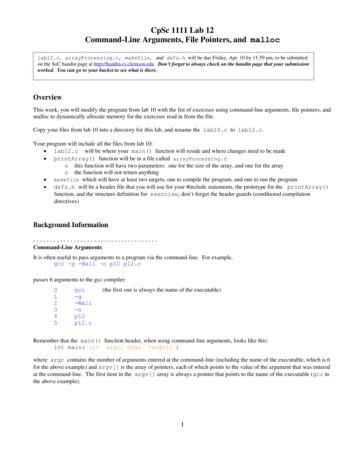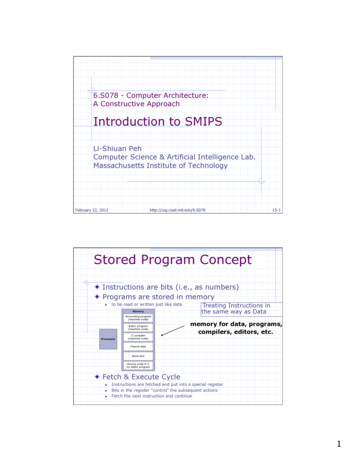CpSc 1111 Lab 12 Command-Line Arguments, File Pointers .
CpSc 1111 Lab 12Command-Line Arguments, File Pointers, and malloclab12.c, arrayProcessing.c, makefile, and defs.h will be due Friday, Apr. 10 by 11:59 pm, to be submittedon the SoC handin page at http://handin.cs.clemson.edu. Don’t forget to always check on the handin page that your submissionworked. You can go to your bucket to see what is there.OverviewThis week, you will modify the program from lab 10 with the list of exercises using command-line arguments, file pointers, andmalloc to dynamically allocate memory for the exercises read in from the file.Copy your files from lab 10 into a directory for this lab, and rename the lab10.c to lab12.c.Your program will include all the files from lab 10: lab12.c will be where your main() function will reside and where changes need to be made printArray() function will be in a file called arrayProcessing.co this function will have two parameters: one for the size of the array, and one for the arrayo the function will not return anything makefile which will have at least two targets, one to compile the program, and one to run the program defs.h will be a header file that you will use for your #include statements, the prototype for the printArray()function, and the structure definition for exercise; don’t forget the header guards (conditional compilationdirectives)Background mand-Line ArgumentsIt is often useful to pass arguments to a program via the command-line. For example,gcc –g -Wall –o p12 p12.cpasses 6 arguments to the gcc compiler:012345gcc-g-Wall-op12p12.c(the first one is always the name of the executable)Remember that the main() function header, when using command-line arguments, looks like this:int main( int argc, char *argv[] )where argc contains the number of arguments entered at the command-line (including the name of the executable, which is 6for the above example) and argv[] is the array of pointers, each of which points to the value of the argument that was enteredat the command-line. The first item in the argv[] array is always a pointer that points to the name of the executable (gcc inthe above example).1
------------------------------------File PointersRemember that when a program is run, three files are automatically opened by the system and referred to by the file pointersstdin (associated with the keyboard), stdout (associated with the screen), and stderr (also associated with the screen).Users may also create and/or use other files. These files must be explicitly opened in the program before any I/O operationscan occur.A file pointer must be declared and used to access a file. Declaring a file pointer would be in this general form:FILE * ptr name for example:FILE * inFile;// for an input fileFILE * outFile;// for an output fileinFile and outFile are just variable names, and as you know, you can name your variables whatever you want.Once you have a file pointer declared, you can assign it the return value of opening up a file by calling the fopen() function,which might look something like this:inFile fopen(“inputFileName.txt”, “r”);// “r” opens it for readingIf the file you are trying to open to read from doesn’t exist, the value of the file pointer will be NULL so it’s a good idea tocheck and make sure it was successful before continuing in your program.if (inFile NULL) {fprintf(stderr, “File open error. Exiting program\n”);exit(1);// need to #include stdlib.h for this}If you are opening a file that you will be writing to, you would use “w” or “a” to write or append to a file.outFile fopen(“outputFileName.txt”, “w”);If the file doesn’t already exist, it will be created.When getting the filename from a command-line argument, instead of hardcoding the filename in quotes, it will be comingfrom the argv[] array, so you will have to specify which subscript of the array that it is contained in.Once the file is opened, you can use file I/O functions to get from or write to the file. Some functions get individual character,some get entire strings, some get entire lines, some get entire blocks of data.2
------------------------------------Dynamic Memory AllocationSo far up to this point, when we have declared variables, memory has been reserved at compile time – the compiler knows howmuch memory to reserve, and space is set aside for those variables:int x; // compiler “pushes” (reserves) 4 bytes of memory on the stack for “x”float y; // compiler reserves 4 bytes (on our system) of memory on the stackchar word[10]; // compiler reserves 10 bytes of memory on the stackThere are various reasons for not wanting something to be declared statically, i.e. “pushed” onto the stack at compile time.Sometimes, we do not know how big something will be until the user enters some sort of value; or sometimes the data consistsof a large data structure and we do not want it to be “pushed” onto the stack, especially if it is repeatedly being sent to afunction (each function call copies it onto the stack).These are some reasons to dynamically allocate memory for some data structure being used in a program. Dynamicallyallocated memory:1. uses a pointer to point to the area of memory to be used,2. and, the memory being used is called “heap” memory – not “stack” memory (a different area of memory than thestack)There are a couple of functions to choose from to dynamically allocate memory, both coming from stdlib.h :calloc()malloc()They both return a void pointer, which is a pointer that could be used to point to any data type. Thus, the return type is cast(should be cast) to the type being used.Example code snippet:#include stdio.h #include stdlib.h // calloc(), malloc(), and exit() functionsint main(void) {int * array1;// a pointer that can be used to point to an intint howManyNumbers; // the number of integers that will be in the array// prompt user for the number of ints they want to have memory reserved forprintf(“How many numbers do you want to store?”);scanf(“%d”, &howManyNumbers);array1 (int *)calloc(howManyNumbers, sizeof(int));// 2 argumentsORarray1 (int *)malloc(howManyNumbers * sizeof(int));if (array1 NULL) {// code to print error message// code quit program}// . rest of program3// 1 argument
Lab AssignmentYour program this week will have the same output as lab 10, except that instead of redirecting the filename for the input file,you will get the filename from the command-line, and use a file pointer to open the file. You will also dynamically allocatespace in memory after reading in the first value from the file indicating the number of lean proteins that are in the file.Copy your files from lab 10 into a directory for this lab, and rename the lab10.c to lab12.c. This is the only file wherechanges need to be made.Output should look like this:[17:49:59] chochri@joey3: [2] ./lab12 exercises.txtEXERCISE1. bench press2. squat3. dead lift4. power clean5. hip thrust6. russian twists7. leg raises8. bicep curls9. tricep pulldowns10. tricep kickbacks11. situps/crunchesMUSCLESchest tri shouldersgluts hamstrings quads calveshamstrings lowerBacktotal bodyhamstrings glutsabs obliqueslower 00000000SETS REPS0000000000000000000000For this week’s lab assignment, you will submit four files, lab12.c, arrayProcessing.c, defs.h. and makefile.Reminder About Formatting and Comments The top of all your source files should have a header comment, which should contain:o Your nameo Course and semestero Lab numbero Brief description about what the program doeso Any other helpful information that you think would be good to have. Local variables should be declared at the top of the function to which they belong, and should have meaningfulnames. Function prototypes should appear in the header file. A brief description of each function should appear at the top of the file that contains the function. Always indent your code in a readable way. Some formatting examples may be found here:https://people.cs.clemson.edu/ chochri/Assignments/Formatting Examples.pdf Don’t forget to use the –Wall flag when compiling, for example:gcc –Wall -o lab12 lab12.c arrayProcessing.c4
Turn In Work1.2.Before turning in your assignment, make sure you have followed all of the instructions stated in this assignment andany additional instructions given by your lab instructor(s). Always test, test, and retest that your program compilesand runs successfully on our Unix machines before submitting it.Show your TA that you completed the assignment. Then submit your files to the handin page:http://handin.cs.clemson.edu. Don’t forget to always check on the handin page that your submission worked. Youcan go to your bucket to see what is there.Grading RubricFor this lab, points will be based on the following:Overall functionalityUses command-line arguments for inputfile name instead of using redirectionUses file pointer to open input fileDynamically allocates memory for the leanproteins instead of declaring an arrayChecks that opening file and dynamicallyallocating memory were successfulCode formattingNo warnings when compile2515151515105OTHER POSSIBLE POINT DEDUCTIONS (-5 EACH): There could be other possible point deductions for things notlisted in the rubric, such as use of break not in switch statements naming the file incorrectly missing return statement at bottom of main() function global (or shared) variables etc.5
A file pointer must be declared and used to access a file. Declaring a file pointer would be in this general form: FILE * ptr_name for example: FILE * inFile; // for an input file FILE * outFile; // for an output file inFile and outFile are just variable names, and as you know, you can name your variables whatever you want.
CPSC-62800 Programming for Digital Forensics CPSC-63000 Database Systems CPSC-65500 Cloud Computing and Virtualization CPSC-66000 Programming Languages CPSC-66500 Software Vulnerabilities and Defenses. 5. Admission Requirements In order to be accepted into this program, you mus
Command Library - String Operation Command Command Library - XML Command Command Library - Terminal Emulator Command (Per Customer Interest) Command Library - PDF Integration Command Command Library - FTP Command (Per Customer Interest) Command Library - PGP Command Command Library - Object Cloning
remains, the subnet mask bits define the subnet portion. Whatever bits remain define the host portion. Address 172.16.5.72 1010 1100 0001 0000 0000 0101 0100 1000 Subnet mask 255.255.255.192 1111 1111 1111 1111 1111 1111 1100 0000 Class Net Host First Octet Standard Mask Binary A B C N.H.H.H N.N.H.H N.N.N.H 1-126 128-191 192-223
1-31447 CenterPoint Energy, Inc. 74-0694415 (a Texas corporation) 1111 Louisiana Houston, Texas 77002 (713) 207-1111 1-3187 CenterPoint Energy Houston Electric, LLC 22-3865106 (a Texas limited liability company) 1111 Louisiana Houston, Texas 77002 (713) 207-1111 1-13265 CenterPoint Energy Resources Corp. 76-0511406 (a Delaware corporation) 1111 .
Other Shortcut Keys 28 Command Line Reference 30 Information for DaRT Notes Users 32 . Open command 39 Save command 39 Save As command 39 Close command 39 Recent Files command 39 Clear MRU List command 40 Remove Obsolete command 40 Auto Save command 40 Properties comman
Type the desired command or the command‟s alias at the command prompt. Command : LINE Command: L 2. Press ENTER on the keyboard. 3. Type an option at the command prompt. TIP: Many AutoCAD commands require you to press ENTER to complete the command. You know you are no longer in an AutoCAD command when you see a blank command line.
Chapter 1 Slide 1 Introduction to Statistics Click on the bars to advance to that 1-1 Review and Previewspecific part of the lesson 1-2 Statistical Thinking 1-3 Types of Data 1-4 Critical Thinking 1-5 Collecting Sample Data Slide 2 1111----1111 Overview Overview What is Statistics about? In a Nutshell: Slide 3 The Three Major Parts of .
0000 1001 1100 0110 1010 1111 0101 1000 1010 1111 0101 1000 0000 1001 1100 0110 1100 0110 1010 1111 0101 1000 0000 1001 0101 1000 0000 1001 1100 0110 1010 1111 ALUOP[0:3] InstReg[9:11] & MASK High and low signal






















